Part 1:
Part 2:
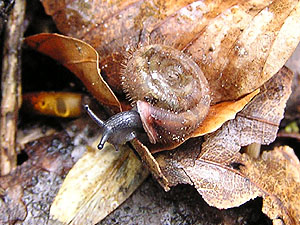 Cheese snail (Helicodonta obvoluta). A juvenile with a hairy shell. Picture: [RN]. |
There are many terrestrial snails with a hairy shell. Those hairs, sometimes present only on juvenile shells, but lacking on the adult ones, are a part of the periostracum, the organic outer shell skin (See Part 1).
A current assumption is that the hairy shell enables the snail to better hold on to wet plant leaves. The hairy shell sticks to the wet surface.
In the leaf snail family (Hygromiidae) there is a genus once referred to as hair snails (Trochulus). There is even a species of that genus called Trochulus villosus, which translates "Furry hair snail" (see an illustration in the paper mentioned below).
The Hygromiidae, however, are not the only terrestrial snail family, in which hairy shells are found: The cheese snail (Helicodontidae family) is another species, which, at least as a juvenile, can have a hairy shell. What the hairy species have in common, is, they all occur in rather humid places, which favours the theory of the hairy shell supporting the snail's hold on wet plants.
And even more astonishing is a Helicid snail with hairs: The mask snail (Isognomostoma isognomostoma).
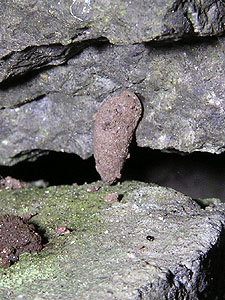 Lesser bulin (Merdigera obscura). [RN] |
Vespericola columbianus and Cryptomastix germana (Polygyridae family) also exhibit a hairy shell. These two species live in the Northwest of the United States and the Southwest of Canada, and they use their hairy shells mainly for camouflage: Dirt particles attach to the hair and so the shell is hard to tell apart from its surrounding.
Another terrestrial snail specialised in camouflage, at least as a juvenile, is common to Europe: Merdigera obscura, the lesser bulin (Enidae). Its systematic name is hardly flattering, as it basically means "excrement bearer". This is because the snail also uses its own excrement to camouflage its shell. That way a lesser bulin sitting in a wall crevice is difficult to tell apart from the surrounding rock.
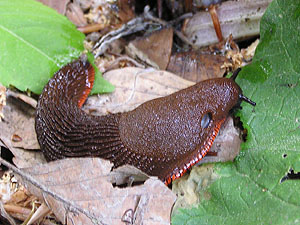 A giant red slug (Arion rufus ?) in the forest. [RN] |
Among snails, the same as among cuttlefish, squids and octopuses (Cephalopoda), there is a tendency towards a reduction of the shell. Generally a snail with a reduced shell is much more mobile than other snails – a considerable advantage.
Numerous predator snail species native to Europe are enabled to better pursue their prey because of their reduced shell. Carnivorous (semi) slugs, such as Testacellidae and Daudebardias (Daudebardiinae), which feed on earth worms, are able to hunt their prey also underground.
The tendency to reduce the shell can however be seen among many snail groups. It is especially well visible in the terrestrial snail family of the glass snails (Vitrinidae). In this family, there are species with a large shell, in which the snail can retreat completely. Other species on have a small semi-slug shell and there are even species, which externally are completely shell-less.
There are of course other snails that completely lack a shell – we call them slugs. But they may have internal shells in different degrees of reduction: The slug families of Limacidae and Milacidae have an internal shell plate, which can be found below the mantle shield. The family of Arionidae on the other hand, except some calcareous grains, completely lacks any trace of even an internal shell.
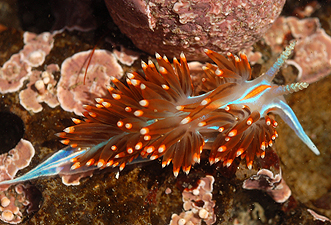 Hermissenda crassicornis, a nudibranch. Picture: Matt Knoth. Source: Wikipedia. |
Slugs of different kinds are not confined to dry land. There are, of course, also species living in the sea: Most members of the marine Opistobranchia (see: Torsion) have a shell reduced to a larger or lesser extent. The sea hare (Aplysia), an opisthobranch, only has a translucent shell left. Many species swimming freely in the sea, such as the pteropod Clione limacina (pteropod means wing-foot), have reduced their shells so completely, that there is almost no trace left. Clione limacina lives in the Arctic Sea and hunts a relative, Limacina helicina, which is much slower and still does carry a shell.
Among the shell-less opisthobranch gastropods there are also the nudibranchs (Nudibranchia). Those colourful sea slugs have dorsal protrusions of the most amazing colours, in which they keep the sting cells (cnidoblasts) of jellyfish and other cnidarians they had fed on. Any predator trying to feed on such a nudibranch, armed with other creatures' weapons, will taste of this defensive effectiveness. The colourful dorsal protrusions by the way are a nudibranch innovation. They also serve as gills, but unrelated to other snails' breathing organs, the have newly evolved among the nudibranchs.
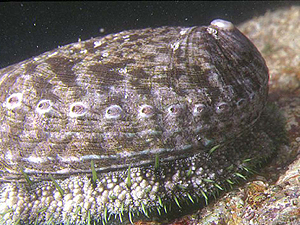 Green ormer (Haliotis tuberculata). Picture: Sue Daly. |
Snails and shells tend to be confounded. But there are basic differences. All marine molluscs bearing a shell are called that – shells. But of course they are not all from the same group. There are differences between snails and mussels or clams that can usually be seen on first sight.
A snail shell always is of one part. Mussels and clams are called bivalves, because their shell is divided into two halves (or valves). Besides, snail shells have a spire, whose whorls usually can be seen at least in a close examination. Bivalve shells never have any spire.
So the green ormer (Haliotis tuberculata) looking like some kind of mussel or clam can clearly be identified as what it is – a gastropod. Ormers or, as they are also called, abalones, may not be bivalves, but they have something on common with them: The inside of their shell is covered with nacre or mother-of-pearl. Abalones are the only gastropods capable of producing pearls. Besides they are also esteemed delicacies, which is why most abalone species are extensively threatened.
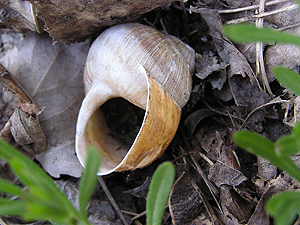 A Roman snail's shell (Helix pomatia). [RN]. |
After a snail has died, the only thing that remains of it is the shell. Most snail shells found in nature, however, have been bleached by the sun. The shell skin, the periostracum (See Part 1), will die, too, after some time. Then the shell's former colours and patterns will be hard to recognise as well.
Sea shells found at the shore usually also are rolled by the tides until their form and structure has been erased to a larger or lesser extent.
The shells that survive because of their mechanical hardness may make valuable fossils. That is why we know mollusc fossils since the Cambrian of more than 500 million years ago and we may follow the path of molluscs throughout the geologic periods.
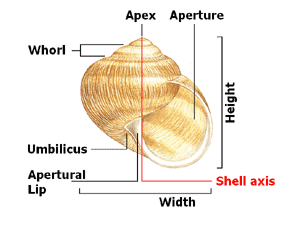 The most important shell characters to be used for identifica- tion. [RN] after Kerney et al. (1983) |
A gastropod shell is largely species specific because of its usually unique form, size, colour and surface structure. Especially between closely related snail species, the shell characters may not suffice to tell them apart. But they can at least be used for an approximate identification, which can then be narrowed for example by an anatomical examination.
In most field guides standardized values for height, width and number of whorls of a shell are given. So it is necessary to first familiarize with those values and their measurement, before attempting to identify a snail species.
It should also be taken into account, that, apart from shells coiled against the species rule (See Part 1) there are also misshapen shells, such as the scalariform shells observed in some terrestrial snail species.
To identify slugs, in absence of a shell, other characters are used for identification, such as the location of the respiratory opening in the mantle shield, colour and structure of the foot and especially also the foot sole, as well as presence or absence of a dorsal keel.